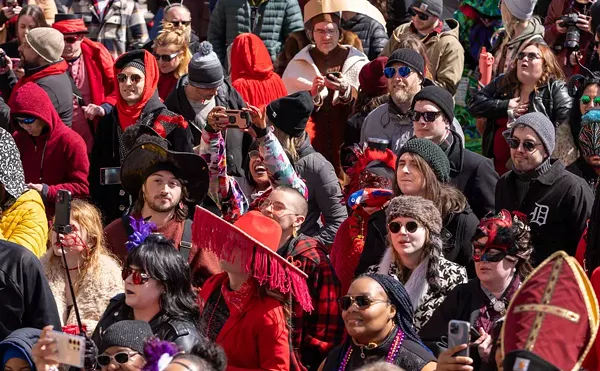Confucius said, "Everything has beauty, but not everyone sees it." For those who do see it, the world is a constant source of astonishment and inspiration.Since he was a young boy, John Korachis has been a "seer." The successful attorney and art collector sips a cup of espresso at a wood table off the side of his kitchen.
"I was born and raised in Greece," he says. "You can't grow up in that environment without being sensitive to all forms of aesthetics. You're surrounded by beautiful mountains and incredible vegetation and the light of the Mediterranean sun, and in particular, the Aegean light."
Korachis looks out a window at the snow-covered garden behind his landmark home in Grosse Pointe Park. The late afternoon sky is dimming to a shade of gray.
"Everywhere I looked, there were ancient artifacts, medieval artifacts," he says. "Even the contemporary architecture, whether it was modest or spectacular, had aesthetic qualities that moved me. Then you had the art forms such as ancient sculpture and Byzantine iconography, which is everywhere. Every church in Greece is a museum. There's frescoes, paintings, metal objects, carved marble columns, the tapestry of the garments of the priest, everything that goes with the pageantry of everyday life."
His current house, which he purchased 21 years ago, is an extraordinary example of modernist architecture, created in 1937 by Alden B. Dow, a student of Frank Lloyd Wright. The concrete-block-and-glass structure is a work of art itself that sat empty for a decade before Korachis restored and expanded it. It's filled with a variety of paintings, sculpture, folk art, iconography, pottery and a collection of African art that's been featured in a traveling show that opened at the Midland Center for the Arts, called Spirits, Relics, and Rituals.
He reads an English translation of the poem, "The Orange Girl," by Odysseus Elytis. An imaginative portrait of the character in the poem hangs near the fireplace in his living room. It's a vivid, emotional painting he commissioned, by local artist Luda Tcherniak.
Like a gallery, Korachis' home is a testimony to the power of art's presence. His "curatorial responsibility" seems to extend beyond the structure itself, inspiring him to support, collect and preserve any art that moves him. He also seems very aware of the impoverishment that takes place in the absence of art.
"Without the humanities," he says. "I think our economic and political system will collapse. We have to incorporate the humanities into our lives."
Korachis is a step beyond art collector. He's a leader and an activist. Several paintings and pieces of sculpture on display in his home — including a metal bench by Detroit artist Ann Marie D'Anna — were also commissioned by him.
He's also the chairman of the scholarship and exhibition committee for the Detroit Artists Market. This year was the third annual student exhibit, and the committee awarded a total of $4,500 in scholarship money to three graduate students of the Cranbrook Academy of Art. Works by these students, nine additional finalists and Cranbrook alumni are currently on exhibit at the DAM.
The exhibit presents a diverse selection of art that includes painting, jewelry, sculpture and textiles. There was also a performance artist among the finalists.
First-place winner Elizabeth Boyd Hartmann's jewelry objects, or wearable sculptures, employ resin, rubber and silver to convey her visions of scientific dissections and radical ideas about adorning the body. Huge lunar spheres are set upon contoured metal bars, which are meant to be held between the fingers as rings. A long curved plastic sculpture is worn from the neck down the center of the back, suggesting an exterior or mirrored spinal column.
A few other pieces in the group are especially captivating. True to the passionate and uninhibited sensibility that Korachis speaks of, Korean student Iris Seo's paintings of naked women strip down, confront, fragment then reassemble the female body in a layered puzzle.
Eric Steinberg uses found objects to fabricate his baseball bat broom and an assembled mummy-like head called "All Hail the King of the Sandlot," which suggests an all-American tribal mask. The piece is covered in skins of old baseballs quilted together with the traditional red stitching. It radiates a sort of ridiculous blind majesty, wearing a crooked Jughead-style crown.
"It was very difficult." Korachis says of the final selection process. "We were voting for several hours to come up with first, second and third. And we finally selected them by the narrowest of margins."
"When you visit the studios of these talented young artists, engage in meaningful dialogue with them and observe their creative expressions," he says, "you realize that Cranbrook is not only a world-renowned center of learning and art, it is a cultural experience. It has an atmosphere, a climate that allows this young generation of artists to express themselves without inhibitions."
The 2008 Annual Detroit Artists Market Scholarship and Exhibition Program runs through April 5 at Detroit Artists Market, 4719 Woodward Ave, Detroit; 313-832-8540.
Norene Cashen is a freelance writer. Send comments to [email protected]





